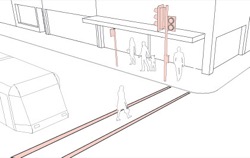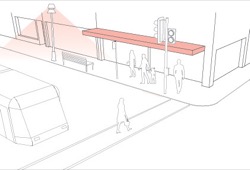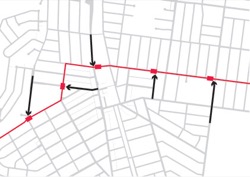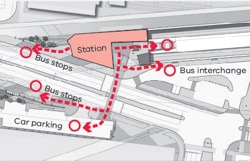On this page:
About public transport on roads
There are two main types of public transport that use the road network:
- the fixed tram network, usually located on major roads and streets
- the bus network, which operates within standard traffic lanes or in bus priority lanes.
Bus and tram priority routes have priority over general traffic.
Why is it important?
Public transport on roads helps move large numbers of people around a city, taking them to work, school, shopping or other activities.
This sub–element focuses on providing people with convenient access to public transport on roads. The engineering, servicing or management issues of the public transport are guided by other appropriate authorities.
Refer to Public Transport Guidelines for Land Use and Development.
2.6.1: ensure public transport stops are located in accessible, convenient and safe places
Public transport stops may be located on the road, kerbside or on centre road refuges.
- Co–locate public transport stops with controlled pedestrian crossings or controlled intersections.

Tip: if a public transport stop is near a traffic hazard, use traffic calming measures to maximise pedestrian safety. - Where a stop is not at a controlled intersection, locate the public transport stop where pedestrians of all abilities can safely cross the road.
Tip: mid–block public transport stops mean pedestrians will need to cross the road to reach their stop or their return destination.
- Locate public transport stops to enable approaching pedestrians and public transport drivers to see the stop.
Tip: sharp curves in the roadway can pose a hazard for pedestrians as car drivers’ sight lines are limited.
- Where possible, integrate shelters for public transport stops into the facade of adjacent buildings.

Tip: integrating shelters, by attaching them onto the building wall, allows the street spaces to remain uncluttered. The Building Code of Australia sets out design standards for building projections beyond the street alignment. Refer to 5.1 Buildings in activities areas, and 6 Objects in the public realm. - Provide seating at public transport stops.
- Provide adequate lighting on pedestrian approach paths to public transport stops.
- Provide lighting at public transport stops to levels that enable public transport drivers to see waiting passengers.
2.6.2: enable travellers to safely reach public transport stops
- Provide direct, convenient pedestrian links from neighbourhoods to public transport stops.

- Provide direct, convenient pedestrian paths connecting between public transport modes.

Tip: an integrated public transport service should provide efficient, safe pedestrian paths connecting public transport modes.
2.6.3: maximise informal surveillance of public transport stops and their access routes
- Position bus and tram stops at locations that have higher numbers of passers–by.
Tip: public transport stops in remote locations receive fewer passers–by and less informal surveillance.
- Locate public transport stops where they are visible from nearby buildings.
- Locate approach paths to public transport stops where the paths are visible from nearby buildings.
2.6.4: maintain the amenity of public transport stop environs
- Maintain public transport stops and surrounds in a clean, safe and well–lit condition.
Tip: ensure damaged shelters, furniture, paving or landscape elements are promptly repaired.
Page last updated: 28/10/25